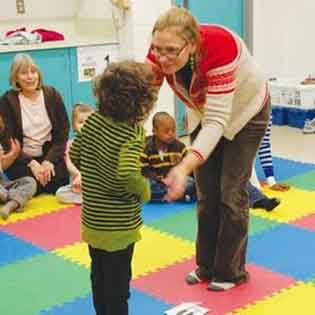Autism, Dance, Performance and Mirroring

Jacqui Russell is the artistic director of Chicago Children’s Theater. My good friend Arnold April mentioned to me the unique program that Jacqui manages at Agassiz Elementary School in Chicago, encouraged into existence by CAPE (Chicago Arts Partnerships in Education). Arnold is CAPE’s creative director.
The program that Jacqui manages guides autistic children into more interactive relationships by blending performance with a sensitivity to the nuances of emotion. An audio interview is located here, an article here, with CAPE documentation of her process located here and here.
The documentation describes a step-by-step process that guides children with deep difficulties intuiting the experience of others into a place where they can estimate another person’s emotion and respond in an appropriate way.
What has me thinking is the possibility of approaching autism with a blending of performance, rhythm and education around emotion, something that this program has been doing to a large degree for more than ten years.
If autistic children can be encouraged to dance to rhythms, dancing to the same beat in a group, experiencing the mirroring of each other’s experience in a performance context, then perhaps bridges can be built between beings with difficulty entering others’ worlds.
Mark Stairwalt, my colleague producing Shift Journal, reminded me of the power of mirrored experience…
“My wife and I have a family friend who once worked as an untrained volunteer with autistic kids, and she astounded the professional staff by achieving a communications breakthrough with one particularly hard-to-reach child. When I asked how she had done it, she told me she had simply mirrored the body language, breathing pattern, facial expression, etc., of the child in question. Empathy expressed via mimicry > instant breakthrough.”
This is the principle of biofeedback, mirroring or establishing rapport taught by the practitioners of Neuro-linguistic Programming, much of it derived from the work of Milton Erickson, the hypnotherapist. It has been discovered that very effective therapists and hypnotherapists engage in mirroring to establish contact with a client’s unconscious. The same principle applies when communicating with a person with autism. Reflecting an autistic person’s experience by mirroring his or her biological rhythms, breathing, heartbeat and movements gives the autistic person purchase on the reflector’s experience. They see you, in no small part, because you, at that moment, are reflecting them.
Engaging in the performance of rhythmic activities, activities that perhaps, as in the Jacqui Russell programs, offer information on how emotions work, also engages the experience of feeling mirrored that is integral to establishing rapport. A group of people performing the same movements at the same time, dancing, are mirroring one another’s experience.
The autistic have trouble establishing rapport. The foundation feature of establishing rapport is mirroring another person’s experience. It is important that the mirrorer genuinely have the feelings that he or she is mirroring, or at least have access to those feelings. Two people having the same feelings while at least one of the two people is mirroring the other’s experience is what makes a sharing authentic.
The performance of two or more people of a rhythm-based experience such as dance places that group into the same physical experience, one that reproduces and generates the dynamics of rapport.
Performance, rhythm, dance and mirroring are perhaps a combination that can leverage an autistic person into an experience that includes another person. Principles of how an unconscious is accessed are combined with an understanding that how we may have evolved may be directly related to the performance of dance and rhythm. If autism is an evolutionary condition featuring characteristics of our species’ ontogeny from a few thousand generations ago, then perhaps an intervention that features both a reproduction of an autistic indigenous environment, dance and rhythm, with a proven doorway to the unconscious, mirroring, can be the opportunity for an autistic person to behave in new and different ways.
Superb programs exist now, such as Jacqui Russell’s work in Chicago schools. Let’s use the principles above to expand those programs. To guide the autistic to have more facile access to their imaginations, it is necessary that we use ours.
…
Proceed to author’s FREE book download on this subject (The book is called Evolution, Autism and Social Change). 10 minute introductory video here.
Andrew Lehman on 11/23/09 in Art/Play/Myth, featured | 1 Comment | Read More
Comments (1)


Given Andrew Lehman’s mention of Jacqui Russell in the feature above, I thought it might be appropriate mention that that her company, Chicago Children’s Theatre is producing “Red Kite Round Up,” a multi-sensory, interactive adventure for children with autism spectrum disorder at the Jay Pritzker Pavilion Choral Rehearsal Room in Chicago’s Millennium Park, Jan. 20 - Feb. 19, 2010.
“Red Kite Round Up” is a 40-minute multi-sensory adventure created for children with autism spectrum disorder ages 5-13 and their chaperones. Guides take 10 children on the autism spectrum on a digitally simulated outdoor trip where they can chase butterflies, hike
trails, star gaze and more.
“Red Kite Round Up” is part of CCT’s ongoing Red Kite Project for children with autism spectrum disorder (ASD) and is the second installation of its kind created by the company. Red Kite also includes “Camp Red Kite,” a summer arts camp for children with ASD and their families encompassing music, movement, drama, arts and crafts and led by a team of artists and special education teachers; and professional development workshops for child educators.
Given the nature of the project, capacity for “Red Kite Round Up” is extremely limited and advanced reservations are required. CCT will begin to take reservations Dec.4. “Red Kite Round Up” is appropriate for ages 5-13. For more information visit their website or call 773.227.0180 x15.